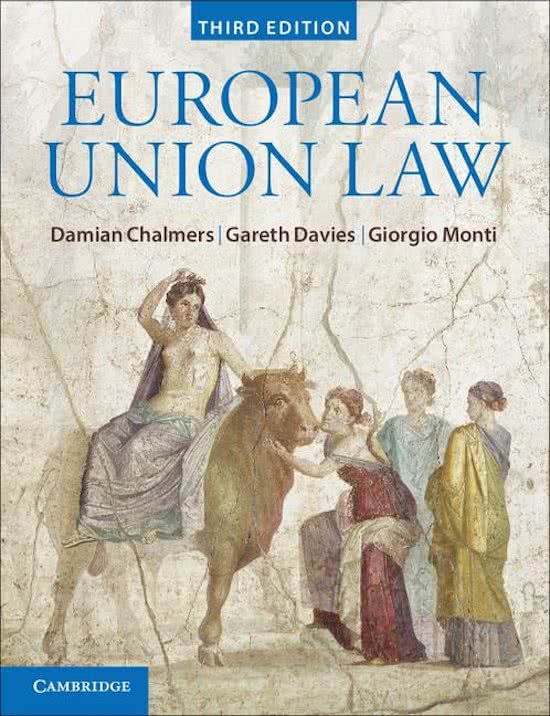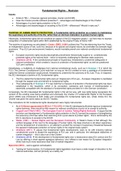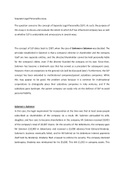Issues:
• Article 6 TEU – 3 Sources (general principles, charter and ECHR).
• Does the Charter provide sufficient protection? – advantages and disadvantages of the Charter
• Advantages of current rights protection in the EU
• Advantages and disadvantages of acceding to the ECHR – differences? Would it make any?
PURPOSE OF HUMAN RIGHTS PROTECTION → Fundamental rights protection as a means to maintaining
the supremacy and authority of the EU, rather than an intrinsic motivation to protect human rights:
Historically, fundamental rights did not constitute an aspect of the EU integration project – as there was no express
recognition of fundamental rights within EEC established by the original Treaty of Rome 1957.
The doctrine of supremacy as articulated in Costa v ENEL (1964) outlines that ‘The law stemming from the Treaty,
an independent source of law, could not, because of its special and original nature, be overridden by domestic legal
provisions’. Thus EU Law and economic freedoms, would invariably prevail over national constitutional fundamental
rights.
• European economic rights would presumptively prevail/were hierarchically superior to constitutionally
protected rights at the national level – which is extremely challenging for Member state autonomy.
• Chalmers (2015) → the constitutional principle of Supremacy ‘threatened to undermine safeguards in
national constitutions’ which created a ‘lacuna in protection of fundamental rights’ as well as questioned
‘EU Law’s authority’.
Nonetheless, a multiplicity of challenges from national constitutional courts, such as in Solange I → in which the
FCC (The German Constitutional Court) held that ‘so long as’ the EU omitted to have a catalogue of fundamental
rights the German constitution would prevail, threatened to undermine the autonomy of EU Law. Thus, in response,
the ECJ developed a doctrine of EU fundamental rights.
• The ECJ stated that fundamental rights were an integral part of EU Law – European integration is facilitated
through the respect and commitment to fundamental rights.
• Thus subsequently in Solange II → it was held that ‘a measure of protection of fundamental rights has been
established in the meantime…which in its conception, substance and manner of implementation is
essentially compatible with the standard of fundamental rights provided for in the German constitution’.
Increasingly, the ECJ developed EU fundamental rights in this ad hoc way, with new rights being recognised, the
content of the existing ones being amplified and eventually the Charter of Fundamental Rights of the European
Union (2000) was introduced to both codify and consolidate EU fundamental rights law. Under Article 6(1) the
Charter was given the same status as the EU Treaties.
The motivations for EU fundamental rights development were highly instrumental:
• As A-G Warner appreciated in IRCA C-7/76 (1976) → If the EU developed sufficiently rigorous fundamental
rights doctrines, there would be little reason for national constitutions courts not to accept its authority.
• Coppell and O’Neil (1992) – The European Court of Justice: Taking Rights Seriously → argue that the
evolution and development of fundamental rights protection in the EU served the purpose of strengthening
the autonomy of EU law rather than stemming from a pure desire to protect rights – this is reinforced by the
ECJ’s reluctance to accede to the ECHR.
• Weiler (1991) – Human Rights and the European Community → Weiler’s thesis is that although ‘the
surface language of the court is the language of human rights, the deep structure is all about supremacy’
and the development of protection is ‘an attempt to protect the concept of supremacy threatened because
the apparent inadequate protection of human rights in the original treaty system’.
• Chalmers (2011) → argues that fundamental rights developments ‘were to do with inducing national
constitutional courts to accept the supremacy of EU Law, and in particular, the ideological objectives of
market integration’ – this is also true of the Charter.
• Chalmers (2015) → the development of fundamental rights was ‘a reassurance about EU conduct and EU
Law by offering a check against egregious behaviour’ and ‘offered a new reason for European integration
which had much more resonance than that of market integration’.
Spaventa (2018) – warns against centralisation.
• “lacking full harmonization, EU fundamental rights legislation must leave a wide margin of discretion to the
national authorities, and act primarily as a safety net.”
, There are various sources of European fundamental rights: This includes the Charter of Fundamental rights,
and European general principles (which are premised upon Member State traditions and the ECHR)
Article 6 TEU → Is the central provision for fundamental rights in the EU.
Advantages/advocates for different sources: The fundamental rights landscape in the EU has always and inevitably
been fractured. This is predominantly because of a lack of an all-encompassing fundamental rights competence.
Chalmers (2011) → Arguably, from one perspective ‘the reference to a multiplicity of sources for
fundamental values…leads to a market place of idea’s in which fundamental rights can flourish’.
- (2015) → ‘This complexity’ may also provide the EU with ‘a normative richness.’ This is because the EU
fundamental rights ‘result from interplay between different instruments, which act to inform and
interrogate each other with the content of fundamental rights remaining an open-ended process’
Craig and De Burca (2011) → However, alternatively, the reality of the situation is that ‘the three sources
overlap, since many provisions of the EU charter are based on the ECHR, creating a certain amount of legal
confusion’.
• The EUCFR and general principles of law both identity the ECHR as a source of law for both of them – whilst
the EUCFR is so broad that it encompasses almost all rights identified in the other sections of Article 6.
• Schutze (2011) ‘Three Bills of Rights for the European Union → The multiplicity of overlapping sources
of uncertain force has been criticised for generating unnecessary complexity and obscurity about the content
of EU fundamental rights.
The EUCFR (2000):
• The Charter of Fundamental Rights provides a written internal bill of rights and principles for the EU, of
which gained legal status in the Lisbon Treaty 2009, it maps out the contours of EU fundamental rights Law.
- Nonetheless, from a human rights perspective, the charter is largely declaratory and fails to sufficiently
strengthen rights protection.
• Article 6(1) TEU → outlines that ‘the Union recognises the rights, freedoms and principles set out in the
Charter of Fundamental Rights of the European Union…which shall have the same legal value as the
Treaties’.
- Therefore, one source of EU fundamental rights is the EUCFR (2000), which are significantly elevated
to the same primacy status as the Lisbon Treaties.
- Nonetheless, as Chalmers (2015) appreciates – ‘its equal to the treaties is…belied by the
subsequence sentence in Article 6 TEU which states that nothing in the EUCFR shall affect the
competences of the Union as defined in the treaties’ (see below), thus the charter is effective ‘subject
to the vision of the powers set out by the treaties’.
Crucially – ‘the provisions of the Charter shall not extend in any way the competences of the Union as
defined in the treaties’, such that the EUCFR fundamentally operates to augment the existent competence
of EU institutions, rather than to extend their authority
- This provides as Chalmers (2015) → appreciates ‘a particularly sensitivity to judicial activism’.
• The Charter includes a right to life, privacy, non-discrimination, health, to vote and the presumption of
innocence.
- Chalmers (2015) → ‘it incorporates a wider array of rights and freedoms than possibly any other human
rights treaty. There are, thus, not just civil, political, economic and social rights, but protection of cultural
and ecological interests as well’. – this is ‘ambitious and nuanced in what it regards humans as needing
for a good life’.
Problems: Spaventa (2018) → ‘the standard of protection at EU level is not always satisfactory’.
• However, Chalmers (2015) – ‘treating everything as fundamental…leads in the end to nothing being special
with a dilution in the value of those entitlements which were once held in the highest regard.’
• Chalmers (2015) → ‘certain important rights are missing. The right to nationality, the right to decent pay,
the tight to work and the right to housing are all not included.’ – ‘number of important rights such as the right
to nationality, decent pay, housing and work are not included in the EUCFR’
• The EUCFR principles are only judicially reviewable enforceable in relation to legislation directly
implementing them, rather than activities which cut across them.
- This is problematic because as Chalmers (2018)→ ‘it is unclear…which entitlements are rights and
which are principles’
- This is particularly so as the Explanations of the Secretariat held that certain rights such as social
security benefits ‘contain both elements of a right and a of a principle’
- So this area may be vulnerable to judicial manipulation and may provide too much flexibility to provide
sufficient protection.






